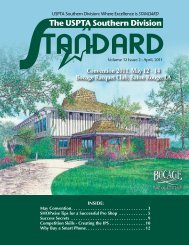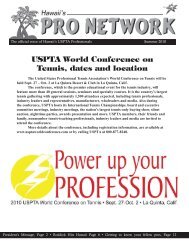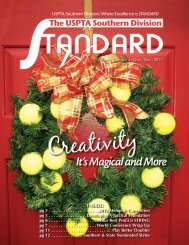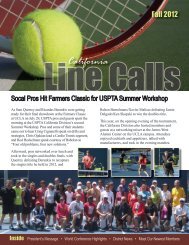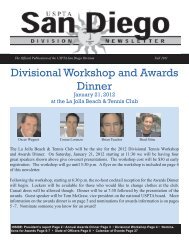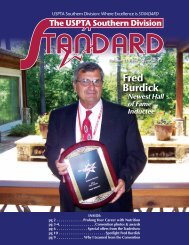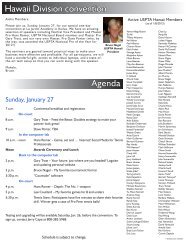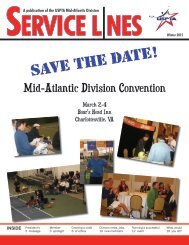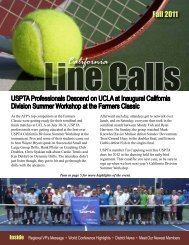INSIDE: - USPTA divisions - United States Professional Tennis ...
INSIDE: - USPTA divisions - United States Professional Tennis ...
INSIDE: - USPTA divisions - United States Professional Tennis ...
Create successful ePaper yourself
Turn your PDF publications into a flip-book with our unique Google optimized e-Paper software.
Standard<br />
Working with Young Players<br />
by Craig Jones-World Conference<br />
Loop Forehand: Craig concentrates on the<br />
unit turn with young players, and does not<br />
teach a loop until the youngster has developed<br />
the strength and motor control to deal<br />
with the more complicated motion. Add<br />
the loop once the core is prevalent in the<br />
stroke.<br />
Open stance: If a child cannot jump side to<br />
side over a cone and keep good balance,<br />
they are not ready to hit open stance.<br />
Touch: Kids develop touch away from the<br />
lessons. Hitting a soft ball in the drive way,<br />
against the garage, or with another friend,<br />
is what develops touch. There is no way<br />
around the fact that touch is a product of a<br />
lot of reps.<br />
Good to Great Lessons<br />
by Ajay Pant -World Conference<br />
Do your students know what you are working<br />
on? Be clear with the purpose of the<br />
lesson.<br />
U S P T A<br />
<br />
What is your energy level between a 1 and<br />
10? He demonstrated various levels, and<br />
the fact that too often we can sink to a<br />
lower level, especially later in the day. Too<br />
much energy is another issue, and this can<br />
drive your students crazy.<br />
Get away from the net post. Teach from<br />
various areas of the court. This shows better<br />
engagement on your part.<br />
Ball pickup is a great time to make a connection<br />
with your students. This down time<br />
is a great chance to just chat and learn<br />
about each other.<br />
Painless QuickStart Court Setup<br />
by Jorge Capestany<br />
One of the complaints about the QuickStart<br />
format is setting up nets and laying down<br />
lines for each practice or match. A quick<br />
way to set up the 60 foot courts without<br />
having to re-measure is to make a permanent<br />
but inconspicuous dot on the court<br />
where the baseline and sidelines meet (3'<br />
from the sideline and 9' from the baseline).<br />
Watch the one Colors more good idea<br />
by Peggy Schuster<br />
to come<br />
1910-2010<br />
The Ball Matters <br />
www.pennracquet.com<br />
Page 13<br />
Great Ideas from Top <strong>Professional</strong>s<br />
around the Country!<br />
For clay courts a colored nail on the tape at<br />
9' from the baseline on either singles sideline<br />
can also be a quick reference point.<br />
Also, have the kids set the courts up, lines<br />
and nets - they love to be in charge and<br />
one kid can be the leader each week.<br />
When I teach 3 and 4 year olds I have<br />
found that a phrase like "watch the ball" is<br />
not easily understood by them. What has<br />
worked for me is to say "what colors are on<br />
the ball?" (Since we use the foam ones they<br />
say "red" and "yellow"). I then ask them to<br />
tell me what color hits their strings when<br />
they swing. It certainly has seemed to help<br />
them watch the ball.



